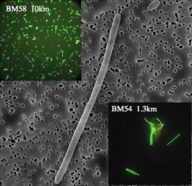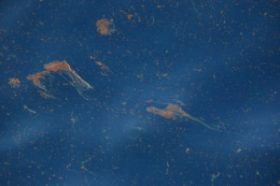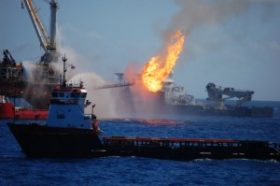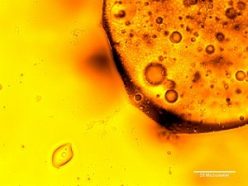Floor of Gulf got slimed
Oil from BP spill was likely dragged down by bacterial goo

Memories of last year’s mammoth oil spill may be fading, but on the bottom of the Gulf of Mexico, plenty of reminders persist. Patches of oil litter the seafloor. Some are small, like droplets that sprinkled down from above; others are thick carpets of oil.
In February, Samantha Joye from the University of Georgia in Athens presented video of the oil patches and discussed the widespread leftovers. Her audience was made up of people attending the annual meeting of the American Association for the Advancement of Science, held this year in Washington, D.C.
Joye spent much of last year studying underwater plumes of oil from the 2010 spill. She is a biogeochemist, which means she studies the biological and chemical processes in specific natural environments.

The spill began April 20 last year, when an explosion killed 11 people on BP’s Deepwater Horizon drilling platform in the Gulf of Mexico. A long pipe attached the platform to an underwater oil well, nearly a mile below the surface. That pipe broke, fell to the seafloor and eventually was removed from the top of the well. Oil spewed out until the well was capped on July 15. Since the accident, scientists have been studying the area to understand what’s happening ― and to understand any changes the spewed oil or efforts to clean it up may have caused.
Joye reported evidence that the BP oil that her research team found on the bottom of the Gulf may have sunk thanks to something she calls “microbial spit.” The ocean is teeming with microbes, in this case bacteria, some of which snack on oil. These bacteria produce a gooey slime that contains surfactants, which are chemicals that break down big blobs of oil. (Dishwasher detergents and laundry soaps also contain surfactants, which is why they can remove stains.)

Joye suspects that as the slime picks up more oil and other goo from the seawater, it gets heavy and sinks, taking oil with it. To test the idea, she and her colleagues did a simple experiment in the lab. They added a small amount of oil to a liter of oil-free water taken from the Gulf and watched what happened.
After a day, the bacteria living in the water found the oil and began to grow. These bacteria produced slime. After a week, the bacteria and oil blobs, held together by slime, began to sink to the bottom. After two weeks, long trails of slime showed up — similar to the ones that show up in photographs of the Gulf seafloor, Joye said. And other long trails have been photographed at a variety of depths in the Gulf. As they gather enough oil and other debris, these slime strands will most likely sink.
“The stuff we’re seeing in the lab forming from the addition of oil is very similar looking to what we see on the bottom,” Joye told the audience.

Joye and her team also collected samples of sediment from the bottom of the Gulf to study how the oil is affecting underwater life. Sediment is the grainy mixture of dirt, sand and rocks that makes up the surface of the seafloor. Joye and her team found signs of microbial spit in the uppermost layers of sediment. Where they found the oily goo, they found damage, including dead corals and crabs. The scientists also found soot in the soil samples, probably left over from the fires that were used after the spill to burn up some of the excess oil.
Much of the oil from the spill has now sunk to the bottom, where it is out of sight but not out of mind. It’s important for scientists to keep watching for more signs of damage, Jane Lubchenco told reporters at the same meeting. Lubchenco is the administrator of the National Oceanic and Atmospheric Administration, a government organization that keeps track of environmental changes through scientific research.
But, Lubchenco warned, there’s a practical problem that gets in the way: “One of our current challenges is that there is no obvious source of funding for that ongoing monitoring.”
POWER WORDS (adapted from the New Oxford American Dictionary)
bacteria Single-celled organisms that can live in soil, water and air, as well as on — or in — plants and animals.
surfactants Chemicals that may be used as detergents. They help separate liquids and liquids, or liquids and solids ― like separating an oil stain from a favorite shirt, or breaking up big globs of oil in the Gulf.
microbe A micro-sized organism, another name for a bacterium.
sediment Matter that settles to the bottom of a liquid, or to the bottom of a river, lake, sea or ocean.







